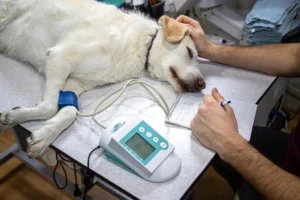In the serene town of Renton, WA, where dogs are cherished as beloved family members, the threat of Gastric Dilatation-Volvulus (GDV), also known as bloat, looms as a critical emergency that can strike without warning. Dr. Arshdeep Mann and the skilled team at Happy Tails Animal Hospital are at the forefront of preventative veterinary care, offering gastroplexy, a surgical procedure that has proven to be a lifesaver for dogs at risk of GDV. This blog post delves into the essential knowledge every dog owner should have about GDV and the protective measure of gastroplexy.
Understanding Gastric Dilatation-Volvulus (GDV)
GDV is a swift and life-threatening condition where a dog’s stomach fills with gas and twists upon itself, cutting off blood flow and causing tissue death. Without immediate treatment, GDV can be fatal in a matter of hours.
Recognizing the Signs of GDV
- Distended abdomen
- Unsuccessful attempts to vomit
- Restlessness and pacing
- Rapid heartbeat
- Collapse in severe cases
The Lifesaving Role of Gastroplexy
Gastroplexy is a surgical procedure that attaches the stomach to the abdominal wall to prevent it from twisting. While it doesn’t stop the stomach from dilating due to gas, it significantly reduces the risk of the lethal component of GDV: the twist.
When Gastroplexy is Recommended
Dr. Mann advises gastroplexy for:
- Breeds predisposed to GDV, such as large breeds with deep chests (Great Danes, Saint Bernards, Weimaraners, etc.)
- Dogs that have a family history of GDV
- Dogs that have previously suffered from GDV
The Procedure: What to Expect
Gastroplexy can be performed as a standalone procedure or more commonly, alongside spaying or neutering. The surgery involves:
- General anesthesia
- A small incision in the abdomen
- The stomach is then sutured to the abdominal wall to prevent twisting
Recovery and Care Post-Surgery
Recovery from gastroplexy typically involves:
- Short hospital stay for monitoring
- Pain management
- Restricted activity during the healing process
- Follow-up visits to ensure proper healing
Preventing GDV Beyond Surgery
While gastroplexy dramatically reduces the risk of GDV, Dr. Mann emphasizes the importance of holistic preventive measures:
- Feeding smaller, more frequent meals
- Using elevated feeding bowls for large breeds
- Avoiding vigorous exercise around meal times
Happy Tails Animal Hospital: Your Partner in Prevention
Choosing gastroplexy for your dog is a decision that can potentially save their life. Dr. Arshdeep Mann and the compassionate team at Happy Tails Animal Hospital are committed to providing the highest standard of care, from the initial consultation through surgery and recovery.
In the fight against GDV, knowledge, and preventive care are key. Gastroplexy represents a critical intervention that can mean the difference between life and death for at-risk dogs. At Happy Tails Animal Hospital, we’re dedicated to educating pet owners and providing the preventative care needed to protect your beloved pets. For more information on GDV and gastroplexy or to schedule a consultation with Dr. Mann, contact us at 425-254-2779. Together, we can safeguard the health and happiness of your canine companions.
Sources:
- Journal of the American Veterinary Medical Association: Offers studies on the effectiveness of prophylactic gastroplexy in preventing GDV in at-risk breeds.
- American College of Veterinary Surgeons: Provides guidelines and information on GDV and the benefits of gastroplexy.
- Veterinary Clinics of North America: Small Animal Practice: Features articles on the latest advancements in the surgical treatment of GDV, including techniques and outcomes of gastroplexy.





